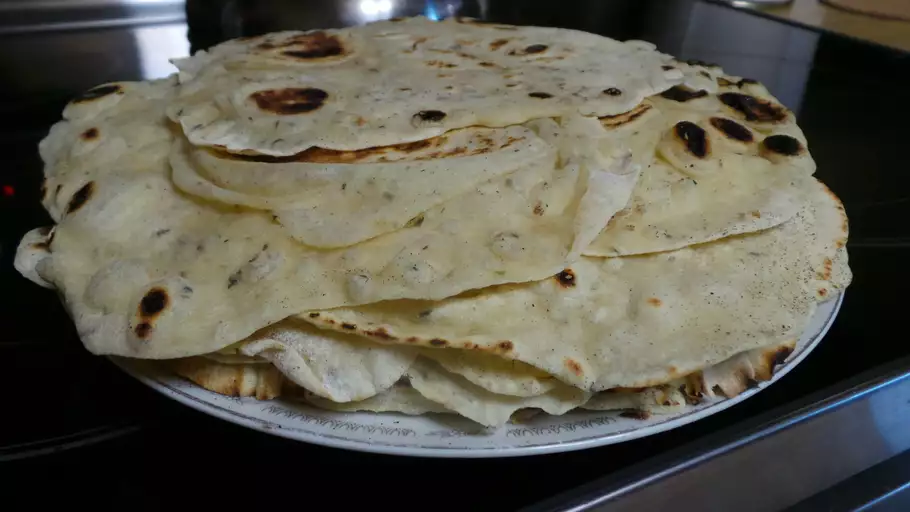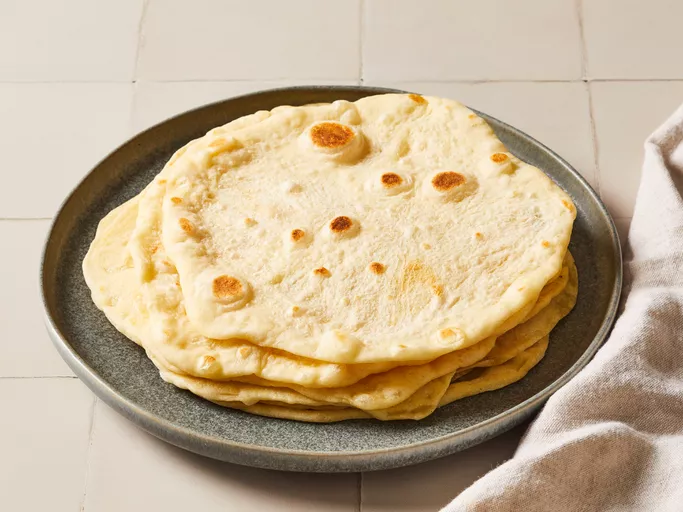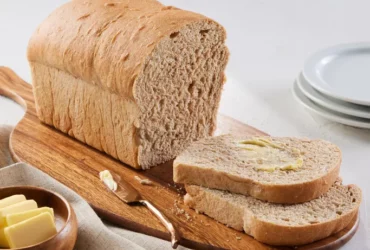Ingredients
Main Ingredients
The key to a delicious and authentic Lebanese Mountain Bread lies in its ingredients, with main ingredients playing a crucial role in defining its taste and texture.
Main Ingredients
- Flour: All-purpose flour is the primary ingredient used to make Lebanese Mountain Bread. A high-protein flour helps to create a chewy crumb and a crispy crust.
- Yeast: Active dry yeast is essential for leavening the bread, providing it with rise and lightness.
- Salt: Salt adds flavor and helps control yeast growth. Use plain or sea salt, as it complements the other ingredients without overpowering them.
- Sugar: A small amount of sugar is added to feed the yeast during fermentation, promoting even rise and browning.
Other essential ingredients include:
- Olive oil: This healthy fat helps maintain moisture in the dough, while also contributing a subtle flavor.
- Warm water: The right temperature of the water is vital for yeast activation and even dough development.
In addition to these primary ingredients, some variations may include:
- Chopped nuts or herbs: Introduce a crunchy texture or fragrant flavor with ingredients like walnuts, pistachios, rosemary, or thyme.
A blend of all-purpose flour and bread flour can add more structure to the loaf. Be mindful that overmixing may affect its delicate texture.
When it comes to baking traditional Lebanese Mountain Bread, also known as Khubz or Manaqish, the right ingredients are crucial for achieving that perfect balance of flavors and textures. The key to making this crusty bread lies in using high-quality ingredients, many of which can be found at most Middle Eastern grocery stores.
The primary ingredient for Lebanese Mountain Bread is flour, specifically all-purpose flour or a combination of all-purpose and bread flour. Using bread flour will give your loaf a chewier texture and a slightly denser crumb.
Salt is another essential component in this recipe, adding depth to the flavor of the bread. However, it’s worth noting that Lebanese Mountain Bread typically doesn’t have a lot of salt added to it, so use it sparingly. A good quality kosher salt or sea salt will work well for this recipe.
The yeast used in making Lebanese Mountain Bread is usually instant yeast, which has been pre-activated and ready for immediate use. However, if you’re using active dry yeast, make sure to activate it according to the package instructions before adding it to your dough.
Water plays a crucial role in helping the dough come together, as well as developing its texture. Use cold water when mixing the dough, especially during the initial stages of development. As the dough comes together, you can gradually increase the temperature of the water for kneading and shaping purposes.
A key ingredient in many Lebanese recipes is olive oil, which not only adds a rich flavor but also helps with browning during baking. Choose a high-quality extra virgin olive oil or neutral-tasting light olive oil to complement your bread’s flavors without overpowering them.
Some variations of the recipe call for the use of sesame seeds on top of the dough before baking. These seeds provide additional texture, crunch, and flavor to your finished loaf, which is a defining characteristic of traditional Lebanese Mountain Bread.
Other ingredients that can be added to create various flavor profiles or textures include spices such as cumin, coriander, cinnamon, nutmeg, cardamom, etc. Additional toppings like za’atar, sumac, thyme, rosemary, garlic, etc., can also enhance the flavors of your bread.
Finally, traditional Lebanese Mountain Bread relies on a simple leavening agent such as baking powder or natural yeast to achieve its characteristic air pockets and texture.

1 1/2 cups of warm water
The first step to making this authentic Lebanese mountain bread recipe is to prepare a simple and essential ingredient – 1 1/2 cups of warm water.
Warm water plays a crucial role in activating the yeast, which is responsible for the bread’s rise and texture. Using water that’s too hot can kill the yeast, while cold water may slow down the rising process, so it’s essential to strike the right balance.
The ideal temperature for warm water is around 100°F to 110°F (38°C to 43°C), which is perfect for dissolving the yeast and starting the fermentation process. This temperature allows the yeast to activate quickly, while also ensuring that the dough will rise evenly.
In terms of quality, use fresh water from a clean source whenever possible. Avoid using tap water if it’s chlorinated or contains additives that can affect the bread’s texture and flavor. If you’re unsure about the quality of your tap water, consider using filtered or bottled water instead.
For this recipe, 1 1/2 cups of warm water is the perfect amount to create a dough with just the right balance of moisture and elasticity. This amount will allow for easy mixing and kneading, while also ensuring that the final product is light, airy, and deliciously fresh.
2 teaspoons of active dry yeast
The first step in making traditional Lebanese Mountain Bread involves activating the leavening agent that gives this bread its light and airy texture, which is achieved by using active dry yeast.
Active dry yeast requires rehydration before it can be used to help fermentation occur in baked goods, which allows the dough to rise giving it volume and a tender crumb.
To use the active dry yeast, we need to add two teaspoons of it to our recipe. This relatively small amount is enough to support the growth of the yeast, allowing it to ferment the sugars present in the dough effectively.
The importance of using the right type of yeast cannot be overstated as it directly impacts the flavor, texture and overall quality of the bread. Active dry yeast is specifically designed for use in baked goods where liquid ingredients are not abundant and is ideal for making rustic-style breads like Lebanese Mountain Bread.
When substituting active dry yeast with instant or rapid rise yeast, the ratio remains the same, two teaspoons will be required to achieve the same effects but results may vary depending on brand quality and ambient temperatures.
The water used in rehydrating the yeast should be lukewarm. This is crucial because using cold water can slow down the process of activation significantly while hot water can kill the yeast entirely.
3 tablespoons of olive oil
Olive oil is a fundamental ingredient in many Mediterranean and Middle Eastern recipes, including the classic Lebanese Mountain Bread.
In this specific recipe, we’re calling for 3 tablespoons of olive oil, which may seem like a small amount, but trust us when we say it’s essential to achieve the right balance of flavors and textures.
When selecting an olive oil for this recipe, look for one that is high in quality and has a smooth, mellow flavor. You want an oil that complements the other ingredients without overpowering them.
Olive oil serves several purposes in this Lebanese Mountain Bread Recipe:
It helps to create a flaky, tender crust: By brushing the dough with olive oil before and after baking, we’re creating a golden-brown crust that’s both crispy and delicate.
It enhances the flavor: The subtle taste of olive oil adds depth and richness to the bread without overpowering the other ingredients.
It helps to create a soft interior: Olive oil also contributes to the soft, airy texture inside the bread, making it perfect for serving with your favorite dips or spreads.
In terms of substituting other oils, we recommend sticking with olive oil to achieve the authentic flavor and texture of traditional Lebanese Mountain Bread.
That being said, if you’re looking for a lighter option or prefer the taste of another oil, you can experiment with other neutral-tasting oils like avocado oil or grapeseed oil. However, keep in mind that the flavor and texture may be slightly different than with olive oil.
Remember to always use high-quality ingredients to ensure the best results, and don’t hesitate to reach out if you have any questions or concerns about this recipe!
1 teaspoon of salt
When it comes to the Lebanese Mountain Bread recipe, one essential ingredient that plays a crucial role in bringing out the flavors and textures of this traditional bread is salt.
In most cases, a teaspoon of salt is called for in this recipe, which translates to approximately 5 milliliters or about 0.17 ounces.
Salt has various functions in baking, including controlling yeast growth, balancing sweetness, enhancing flavors, and preserving food, among others.
Why Salt is a Must-Have Ingredient
- Regulates Yeast Activity
- Brings Out Flavors
- Enhances Texture
- Promotes Preservation
Selecting the Right Type of Salt
When it comes to selecting the right type of salt for your Lebanese Mountain Bread recipe, you have several options to choose from.
- Table Salt
- Salt Flakes
- Kosher Salt
How Much Salt is Too Much?
While a teaspoon of salt may seem like a small amount, it can easily add up to an excessive amount if not monitored carefully.
- Using too much salt can lead to an imbalance in flavors and textures
- Excessive salt consumption can also have negative health effects
Conclusion
In conclusion, the Lebanese Mountain Bread recipe relies heavily on a teaspoon of salt as one of its essential ingredients.
The importance of salt in this recipe cannot be overstated, and its functions go beyond just enhancing flavors and textures.
3 1/2 cups of all purpose flour
The foundation of this traditional Lebanese Mountain Bread recipe lies in its carefully selected ingredients, which are crucial for achieving the desired texture and flavor.
The bread’s base ingredient is all-purpose flour, with a specific quantity required to produce the perfect balance between softness and structure. The recipe calls for an exact amount of 3 1/2 cups of this versatile flour.
This generous quantity is necessary to create a sturdy yet pliable dough that can be shaped into the characteristic round loaf of Lebanese Mountain Bread.
It’s worth noting that using high-quality all-purpose flour will significantly impact the bread’s overall taste and texture. Look for a brand that offers a balanced combination of protein, fat, and moisture to ensure optimal results.
The precise measurement of 3 1/2 cups ensures that the dough is neither too dense nor too light. This balance is essential in producing the ideal crumb structure and preventing the bread from becoming too flat or collapsing during baking.
When it comes to making delicious Lebanese Mountain bread, the choice and quality of ingredients play a crucial role in achieving its characteristic flavor and texture.
The main ingredients required for this traditional recipe include:
- Flour: Lebanese mountain bread is typically made with a type of flour called “Bread Flour” or “High-Protein Flour”, which has a higher protein content than all-purpose flour. This helps to create the signature chewy texture and crust.
A high-protein flour can be replaced by using a combination of all-purpose flour and vital wheat gluten, but bread flour is always preferred for an authentic taste.
- Yeast: A small amount of yeast is necessary to leaven the dough. Active dry or instant yeast work equally well.
- Water: The water used should be cold, as it helps to prevent over-proofing and ensures even fermentation.
- Salt: A pinch of salt is added for flavor. Fine-grained or kosher salt works well in this recipe.
- Olive oil: This adds a touch of authentic Mediterranean taste and helps to create a tender crumb. Use extra-virgin olive oil for the best results.
In addition to these main ingredients, there are a few optional components that can enhance the flavor and texture of your mountain bread:
- Herbs: Fresh or dried herbs like oregano, thyme, or rosemary add unique flavors.
- Vegetable oil or other fats: Adding some extra fat can make the dough easier to handle.
Remember that high-quality ingredients and attention to detail are key to baking great Lebanese mountain bread. The right balance of ingredients will result in a delicious, crusty bread with a soft interior.
Add-ins
To make this classic Lebanese Mountain Bread, also known as Kubbeh or Gozeh, you will need a variety of ingredients and add-ins. The main ingredients include:
- All-purpose flour: 2 cups, which serves as the base for the dough.
- Salt: 1 teaspoon, added to enhance flavor.
- Sugar: 1 tablespoon, used to balance out the flavors in the dough.
- Instant yeast: 1 teaspoon, which helps the dough rise and gives it a light texture.
- Warm water: 1 cup, used to combine with the dry ingredients to form the dough.
- Eggs: 2 large eggs, added to enrich the flavor of the bread and give it moisture.
- Olive oil: 2 tablespoons, used to brush the bread before baking and add a rich flavor.
For the Kubbeh filling, you will need:
- Ground meat: 1 pound, preferably a mix of lamb or beef, cooked until browned and set aside.
- Onions: 2 medium-sized onions, finely chopped and sautéed until softened.
- Spices: Allspice, cinnamon , and nutmeg to taste, added to the filling for extra flavor.
Optional add-ins include:
- Pine nuts: Chopped pine nuts can be sprinkled on top of the bread before baking for added crunch and texture.
- Sumac: This Middle Eastern spice adds a tangy flavor and is often used as a garnish.
- Feel free to customize your Lebanese Mountain Bread recipe with these ingredients and add-ins to suit your taste preferences!
- The art of baking lies not just in the technique, but also in the quality of ingredients used. For a traditional Lebanese Mountain Bread recipe, one must start with the finest components to achieve that authentic flavor and texture.
Here are the essential ingredients you’ll need:
Main Ingredients
- 2 cups of all-purpose flour
- 1 teaspoon of salt
- 1 tablespoon of sugar
- 1 packet (2 1/4 teaspoons) of active dry yeast
- 1 cup of warm water (around 100°F to 110°F)
Optional Ingredients
- 1 tablespoon of olive oil or vegetable oil
- Chopped fresh parsley, for garnish
- Sesame seeds, for topping (optional)
It’s worth noting that Lebanese Mountain Bread is often made with a type of flour called “Baladi” flour, which has a slightly coarser texture than all-purpose flour. If you can find Baladi flour, it will yield a more authentic result.
As for the yeast, make sure to use active dry yeast, as instant yeast or rapid rise yeast may not produce the same flavor and texture. Always check the expiration date of your yeast to ensure its potency.
The sugar is added to help feed the yeast during fermentation, resulting in a lighter and airier dough. You can omit it if you prefer, but keep in mind that your bread might be slightly denser.
Using warm water instead of cold water helps the yeast activate faster, which in turn accelerates the proofing process. However, be careful not to overheat the water, as this can kill the yeast.
The olive oil or vegetable oil adds flavor and tenderness to the bread. Feel free to omit it if you’re watching your calorie intake or prefer a more traditional approach.
Garnishing with chopped parsley gives the bread a pop of color and freshness, but it’s entirely optional. You can also top it with sesame seeds for added texture and nutty flavor.
Optional: sesame seeds, poppy seeds, or za’atar for added flavor and texture
The ingredients used in traditional Lebanese Mountain Bread Recipe are relatively simple yet flavorful. At its core, this bread requires a combination of common pantry staples along with some optional add-ins that contribute to its unique flavor and texture.
For the basic dough, you will need flour, salt, sugar, instant yeast, and warm water. The type of flour used is typically all-purpose flour or bread flour. Using bread flour will give a more dense and chewy crumb, while all-purpose flour yields a lighter and airier texture.
The amount of sugar added to the dough may seem minimal, but it plays a significant role in balancing out the flavor. Sugar helps to regulate yeast growth, ensuring that your dough rises evenly and predictably.
Instant yeast is another critical ingredient, as it provides the necessary leavening action to make your bread rise. The use of instant yeast simplifies the process by eliminating the need for a lengthy resting period at room temperature before rising.
Salt is often overlooked, but it has a profound impact on flavor and texture. It enhances the overall taste while acting as a natural preservative that helps extend the shelf life of your bread.
As for the optional ingredients, sesame seeds, poppy seeds, or za’atar can be sprinkled on top of the dough to give it an added layer of flavor and texture. Sesame seeds bring a nutty taste and crunchy texture, while poppy seeds offer a subtle nuttiness and softness.
Za’atar, which typically includes thyme, oregano, marjoram, and toasted sesame seeds, brings a complex blend of earthy, herbaceous notes. This is the most distinctive and fragrant option, perfect for adding depth to your Lebanese Mountain Bread Recipe.
To make authentic Lebanese Mountain bread, you’ll need to gather the right ingredients. The key to this recipe lies in using high-quality and traditional ingredients that reflect the country’s rich culinary heritage.
The primary ingredient for Lebanese Mountain bread is flour. You can use a combination of all-purpose flour and semolina flour to achieve the signature texture and flavor. Semolina flour has a coarser texture than all-purpose flour, which helps to create the characteristic chewiness of traditional Lebanese bread.
Another essential component is yeast. Lebanese Mountain bread relies heavily on natural yeast fermentation, so make sure to use active dry yeast or instant yeast to help your dough rise.
Salt and sugar are also crucial ingredients in this recipe. Use a coarse salt to bring out the flavors of the bread, and a small amount of granulated sugar to balance the flavor.
Lemon juice is often added to the dough to give Lebanese Mountain bread its distinct flavor profile. Freshly squeezed lemon juice will add brightness and depth to your finished bread.
Butter or ghee (clarified butter) can be used in some variations of this recipe, depending on personal preference and regional traditions. Feel free to add a small amount to the dough for extra richness and tenderness.
The final ingredient is water, which should be at room temperature when mixing with the yeast and other ingredients. This will help the fermentation process start smoothly.
Instructions
Mixing the Dough
To mix the dough for Lebanese mountain bread, follow these steps:
- The first step is to combine 2 cups of warm water and 1 teaspoon of sugar in a large mixing bowl.
- Next, add 4 cups of all-purpose flour to the bowl, and use your hands or a wooden spoon to mix until just combined.
- Add 1 teaspoon of salt, 2 teaspoons of active dry yeast, and 2 tablespoons of vegetable oil to the mixture, and continue mixing until a shaggy dough forms.
- Gradually add more flour as needed to create a smooth and elastic dough.
Mixing the dough can be done in several ways:
- Add ingredients one at a time, allowing each ingredient to incorporate fully before adding the next. This helps prevent overworking the dough and creates a tender crumb.
- Use a gentle folding motion with your hands or a wooden spoon to develop the gluten in the dough without developing it too much.
- Don’t overmix the dough, as this can create a dense bread with a tough crust.
If you’re using a stand mixer to mix the dough, use the paddle attachment and follow the manufacturer’s instructions for mixing time and speed.
A key factor in mixing the dough is to achieve the right balance of ingredients and moisture. The dough should be slightly sticky when mixed but not too wet or too dry.
The key to creating authentic Lebanese Mountain Bread is understanding and following precise instructions.
This traditional flatbread, also known as Muhammar, requires a specific technique when it comes to mixing the dough ingredients, kneading, resting, and baking.
The first step in making this bread is to combine 1 cup of warm water with 2 teaspoons of active dry yeast, allowing it to sit for 5-10 minutes or until it becomes frothy and bubbly.
Next, add 3 cups of all-purpose flour, 1 teaspoon of salt, and 2 tablespoons of olive oil. The mixture should come together in a shaggy dough, which will then require kneading for about 10 minutes to develop the gluten.
Once the dough has been kneaded, shape it into a ball and place it in a lightly oiled bowl. Cover the bowl with plastic wrap or a damp cloth and let it rest in a warm, draft-free area for at least an hour, or until it has doubled in size.
To prepare the dough for baking, divide it into 4-6 equal pieces, depending on how large you want your breads to be. Roll out each piece into a thin circle, using a rolling pin if necessary.
Heat a non-stick skillet or griddle over medium-high heat and cook the bread for about 2 minutes on each side, or until it is golden brown and puffed up.
Remove the bread from the skillet and wrap it in a clean cloth to keep it warm. Repeat with the remaining dough pieces.
Once all of the breads have been baked, serve them hot, possibly accompanied by your favorite Lebanese dips or spreads, such as Tahini or Hummus.
Freshly baked Lebanese Mountain Bread is a delicious and satisfying treat that can be enjoyed at any time of day, whether it’s for breakfast, lunch, dinner, or a snack in between.
In a large mixing bowl, combine warm water and yeast. Let it sit for 57 minutes until the yeast is activated.
In the process of creating the classic Lebanese Mountain Bread, it’s essential to understand the importance of proper instructions, especially when it comes to working with yeast.
The first step in making this delicious bread involves activating the yeast. To do this, you’ll need to combine warm water and yeast in a large mixing bowl. The temperature of the water should be around 105°F to 115°F (40°C to 46°C), which is slightly warmer than body temperature.
Allow the mixture to sit for 57 minutes, giving the yeast ample time to activate and become frothy. This step is crucial as it allows the yeast to convert the sugars in the dough into carbon dioxide gas, causing the dough to rise.
During this period, you can use the time to prepare the other ingredients needed for the recipe, such as flour, salt, and sugar. Make sure to have all the necessary ingredients within reach before proceeding with the next steps.
The 57-minute wait may seem like an eternity, but it’s a vital part of the process that will ultimately lead to the creation of light and airy Lebanese Mountain Bread. As you wait, imagine the transformation taking place in your mixture – from a simple combination of water and yeast to a vibrant, rising dough.
When the 57 minutes have passed, your mixture should be bubbly and frothy, indicating that the yeast has been successfully activated. At this point, you can proceed with adding the remaining ingredients and kneading the dough, taking you one step closer to enjoying a freshly baked loaf of Lebanese Mountain Bread.
Add olive oil, salt, and 2 cups of flour to the bowl. Mix well.
In order to prepare the traditional Lebanese Mountain Bread, it is essential to follow a set of specific instructions that will guide you through the process. Below are the necessary steps to create this delicious and authentic bread.
The first step in making Lebanese Mountain Bread involves adding the right ingredients to the bowl. These include:
- Two tablespoons of olive oil
- A pinch of salt
- Two cups of all-purpose flour
It is crucial to mix these ingredients well, ensuring that they are evenly combined and ready for the next step in the process.
Now that we have added and mixed our initial ingredients, let’s move on to the next stage. The instructions below outline how to proceed with making the Lebanese Mountain Bread:
- Add yeast to the mixture and let it sit for a specified amount of time, allowing the dough to rise.
- Knead the dough thoroughly until it becomes smooth and elastic.
- Form the dough into balls or shapes as desired.
- Let the bread rest for a certain period before baking.
Baking is an essential part of making Lebanese Mountain Bread. It requires attention to detail, patience, and following the correct instructions:
- Preheat your oven to the recommended temperature (usually around 400°F or 200°C).
- Place the dough on a baking sheet lined with parchment paper.
- Bake for a specified amount of time, ensuring that the bread is golden brown and cooked through.
With these instructions in place, you are now well-equipped to create authentic Lebanese Mountain Bread. By following each step carefully, you will be able to produce delicious, homemade bread that captures the essence of this traditional recipe.
Instructions are a fundamental component of any recipe, including the Lebanese Mountain Bread Recipe. They provide the necessary guidance for individuals to follow a series of actions or steps in order to achieve a specific outcome or result.
Effective instructions are clear, concise, and unambiguous, allowing readers to easily understand what is expected of them. In the case of the Lebanese Mountain Bread Recipe, instructions might include information on preparing ingredients, mixing dough, kneading the mixture, shaping the bread, baking it in the oven, and cooling the finished product.
Instructions can vary greatly depending on the recipe or task at hand. Some recipes may require precise measurements and exacting techniques, while others may be more flexible and open to individual interpretation.
In general, good instructions should provide the following elements:
- A clear list of ingredients needed for the recipe
- Step-by-step procedures for preparing the dish, including any necessary cooking or baking times
- Detailed information on any specific techniques or methods required to achieve the desired result
- Any relevant safety precautions or warnings that readers should be aware of
- A clear indication of what the finished product should look like and taste like
By following these guidelines, individuals can ensure that they are providing accurate and useful instructions for others to follow.
In the context of the Lebanese Mountain Bread Recipe, instructions might include information on preparing ingredients such as all-purpose flour, yeast, salt, sugar, and water. The instructions could also provide guidance on mixing the dough, kneading it, shaping the bread, and baking it in a hot oven until golden brown.
The final product of these instructions should be a delicious and authentic Lebanese Mountain Bread that is enjoyed by individuals all over the world.
The process of following instructions requires attention to detail and careful observation. When it comes to preparing a traditional dish like Lebanese Mountain Bread, having clear instructions can make all the difference between success and failure.
Types of Instructions
Culinary Instructions
These are specific steps that must be followed in order to prepare a particular recipe. In the case of Lebanese Mountain Bread, these might include mixing together flour, water, salt, and yeast, kneading the dough for a certain amount of time, and letting it rise before baking.
Method Instructions
These provide detailed steps on how to perform a specific action. For example, in the context of Lebanese Mountain Bread, method instructions might explain the best way to roll out the dough, shape the bread into its characteristic round form, and bake it until golden brown.
Material Instructions
These specify the tools or equipment that are required to perform a particular task. In the context of Lebanese Mountain Bread, material instructions might include recommendations for the type of flour to use, the size and shape of the baking sheet, and any special cooking utensils needed.
In order to successfully prepare Lebanese Mountain Bread, it is essential to have clear instructions that are easy to follow. This includes:
Key Ingredients and Equipment
- Active dry yeast: 1 teaspoon
- Salt: 1/4 teaspoon
- All-purpose flour: 2 cups
- Warm water: 1 cup (around 105°F)
- Cooking oil or butter for brushing: as needed
- Baking sheet lined with parchment paper: 1
In addition to following the recipe, there are several tips that can help ensure success when preparing Lebanese Mountain Bread:
Tips and Tricks
- Make sure to knead the dough for at least 10 minutes in order to develop gluten and create a smooth, elastic texture.
- Use a hot oven: preheat your oven to 425°F (220°C) or as hot as it will go.
- Bake the bread for at least 20-25 minutes on each side in order to achieve a crispy crust and a soft interior.
- Brush the top of the bread with oil or butter before baking to add flavor and texture.
By following these instructions and tips, you should be able to successfully prepare delicious Lebanese Mountain Bread in your own kitchen!
Tips and Variations
Shaping the Bread
When it comes to shaping the Lebanese mountain bread, there are a few tips and variations that can help achieve the perfect shape.
Traditional Shaping Method:
- Start by rolling out the dough into a ball and then flattening it slightly into a disk shape.
- Gently stretch the dough into an oval or oblong shape, making sure to maintain even tension throughout the dough.
- Place your thumbs in the center of the dough and push down slightly to create a dimple, which will help the bread expand evenly during baking.
Variations:
- Twist method: After flattening the dough, use your fingers to twist the edges of the bread towards the center, creating a rope-like effect.
- Folding method: Fold the dough in half lengthwise, then fold it in half again, creating a compact shape that will expand during baking.
Tips for Achieving the Perfect Shape:
- Make sure the dough is at room temperature and has been allowed to relax for at least 30 minutes before shaping.
- Use a light touch when handling the dough, as excessive pressure can cause it to become misshapen.
- Keep an eye on the dough’s tension and adjust accordingly – if it becomes too tight, you may need to let it relax for a bit longer before shaping.
By following these tips and variations, you should be able to achieve a beautifully shaped Lebanese mountain bread that’s perfect for serving with your favorite dishes.
To achieve the perfect Lebanese mountain bread, it’s essential to experiment with various tips and variations that can elevate its flavor and texture.
One way to enhance the flavor of your Lebanese mountain bread is by incorporating different types of cheese into the dough. Feta, parmesan, or goat cheese can be added in various combinations to create a unique taste experience.
Another variation is adding some chopped herbs like parsley, oregano, or thyme to the dough for an extra layer of flavor.
If you want to try something more adventurous, consider adding some dried fruits like cranberries or cherries to the dough for added sweetness and texture.
Anchovies or olives can be used as a savory element to add depth to your Lebanese mountain bread.
For those looking for a vegetarian option, you can substitute the meat with roasted eggplant, zucchini, or red peppers for added flavor and nutrients.
Some bakers also like to add some spices like cumin or paprika to give their bread an extra kick.
Don’t be afraid to experiment with different types of flour, such as whole wheat or spelt, to create a nuttier flavor and denser texture.
To achieve the characteristic puffed shape of Lebanese mountain bread, make sure to bake your bread in a very hot oven, preferably at 500°F (260°C) for the first 10-15 minutes.
Rotate your baking sheet every 5 minutes to ensure even cooking and prevent burning.
To get that perfectly golden crust, brush your bread with some water or egg wash before baking.
Keep an eye on your bread while it’s baking as the cooking time can vary depending on the size of your loaf and your oven temperature.
The perfect Lebanese mountain bread should be soft and fluffy inside with a crispy, golden crust on the outside.
To make the perfect Lebanese mountain bread, also known as “khubz bil sharieh,” it’s all about mastering a few simple techniques and experimenting with different variations to suit your taste.
Here are some valuable tips and suggestions to enhance your baking experience:
- Use quality ingredients: Fresh yeast, fine wheat flour, and pure water will yield a lighter and airier crumb. Don’t skimp on the salt, as it helps control yeast growth.
- Mix wet and dry ingredients separately before combining them to ensure even distribution of yeast and prevent lumps from forming.
- Avoid overworking the dough; gently knead until it becomes smooth and elastic. This will help preserve the delicate texture of the bread.
- Use a hot oven or stone to achieve a crispy crust and a soft interior, reminiscent of traditional Lebanese bakeries.
Variations for the adventurous bakers:
- Add some dried herbs like oregano, thyme, or rosemary to infuse the bread with a Mediterranean flavor.
- Try using different types of flour, such as whole wheat, all-purpose, or bread flour, for varying textures and flavors.
- Incorporate some spices like cumin or coriander to give the bread an extra kick of flavor.
- Experiment with different sweet additions, such as dates, honey, or walnuts, to create a dessert-like version of mountain bread.
These variations can help you adapt this classic recipe to your taste preferences and create a truly unique Lebanese mountain bread experience.
The Lebanese Mountain Bread recipe has its own unique characteristics and techniques that allow for various interpretations and adaptations to suit personal preferences or ingredients on hand. Here are some tips and variations that can enhance your baking experience.
For a crisper crust, it is recommended to preheat the oven to 450°F (230°C) with a pizza stone inside. Once you place the dough on the preheated stone, bake for about 10-12 minutes or until the bread is golden brown and crispy.
To achieve a more authentic look, try using a mixture of all-purpose flour and whole wheat flour in your recipe. This will give the bread a coarser texture and a slightly nutty flavor, characteristic of traditional Lebanese Mountain Bread.
If you want to make individual servings or smaller loaves, simply divide the dough into 4-6 equal pieces after the rising stage. Roll each piece into a ball, then flatten it slightly using your hands or a rolling pin. Place them on a baking sheet lined with parchment paper and bake at the same temperature as before.
For an extra crunchy exterior, try brushing the top of the bread with some water and sprinkle with sumac, sesame seeds, or even za’atar before baking. This will add an aromatic flavor and texture to your Mountain Bread.
To make the recipe more convenient, you can prepare the dough ahead of time by refrigerating it overnight or freezing individual portions for later use. Simply thaw and let it rise at room temperature when you’re ready to bake.
The art of making Lebanese Mountain Bread, also known as Khubz al-Jebn, involves a delicate balance of ingredients and techniques that can result in a crispy crust and a soft interior. One key aspect of achieving this perfect blend is understanding the various tips and variations for preparation.
Preparation Techniques
- The use of warm water is crucial, as it helps to activate the yeast and kick-start the fermentation process. However, be careful not to use boiling water, which can kill the yeast altogether.
- Mixing the dough with a wooden spoon or spatula instead of a stand mixer will help to develop the gluten in the bread more evenly, leading to a better texture.
Another essential aspect is letting the dough rest and ferment for an adequate amount of time. This allows the yeast to break down the sugars in the dough and produce lactic acid, resulting in a tangy flavor and a slightly sour taste. It’s recommended to let it sit at room temperature (around 75-80°F) for 2-3 hours or in the refrigerator overnight for a more intense flavor.
Ingredient Variations
- Some people prefer adding garlic to their dough, giving their Lebanese Mountain Bread an aromatic twist. Simply mince two cloves and add them to your mix.
Another variation that’s gaining popularity is using a combination of all-purpose flour and whole wheat flour for the dough. This results in a more nutritious bread with a richer flavor profile. Just remember that you might need to adjust the liquid content accordingly, as whole wheat flour tends to absorb more water.
Shaping and Baking
- To achieve that perfect, round shape, try not to over-stretch or pull the dough when shaping it. Instead, gently fold the edges under the center of the bread to create a smooth surface.
When baking the Mountain Bread, use a pizza stone in your oven for an extra crispy crust. Preheat your oven to 500-550°F (260-290°C) with a baking sheet on top and the stone below. Once hot, carefully place the dough on the preheated stone or baking sheet, and bake for around 15-20 minutes or until it’s golden brown.
- Best Datanyze Alternatives for 2025 - April 24, 2025
- Best Hunter.io Alternatives for 2025 - April 22, 2025
- Best Lead411 Alternatives for 2025 - April 22, 2025














